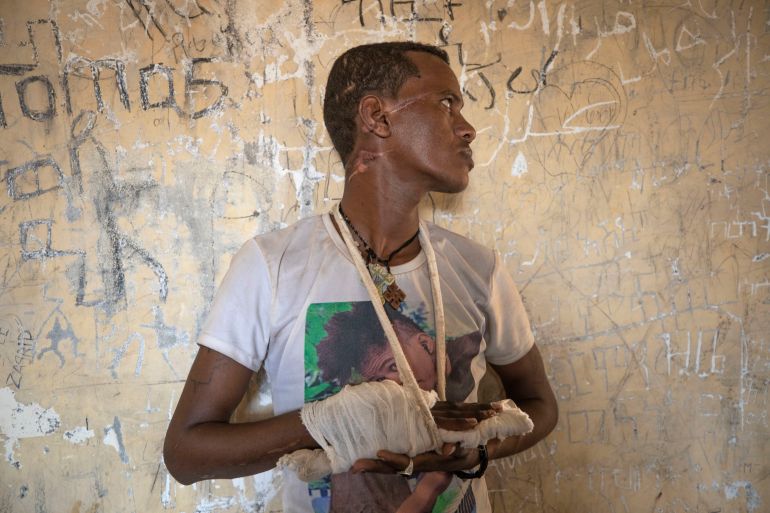Killings in Axum by Eritrea troops ‘may amount to war crimes’
Amnesty says in new report that hundreds of civilians were killed by Eritrean troops in Ethiopian town of Axum last November.

The killings of hundreds of civilians by Eritrean troops in the ancient Ethiopian town of Axum in November last year amounted to “a series of human rights and humanitarian law violations”, according to Amnesty International.
The killings in Axum, located some 187km (116 miles) north of Mekelle, capital of the Tigray region, occurred during the armed conflict between Ethiopia’s federal government and the Tigray People’s Liberation Front (TPLF) last year.
Keep reading
list of 4 itemsEthiopia shuts two Tigray camps housing Eritrean refugees
Ethiopia’s Tigray conflict and the battle to control information
UN: Tigray malnutrition ‘very critical’, response woefully poor
On November 28 and 29, Eritrean troops killed hundreds of civilians in a “coordinated and systematic” manner in order “to terrorize the population into submission”, the report, released on Friday, said.
The 41 witnesses and survivors of the massacre, all ethnic Tigrayans interviewed by Amnesty, said Eritrean forces carried out extrajudicial executions and engaged in widespread looting.
The violations began on November 19 when Eritrean and Ethiopian forces entered Axum, indiscriminately shelling the city and firing at those who tried to flee, Amnesty said, adding that after the massacre, Eritrean forces detained hundreds of residents and threatened renewed killing if they encountered resistance.
The killings, the indiscriminate shelling of Axum and the looting of property “may amount to war crimes”, Amnesty said.
Axum residents identified the perpetrators as Eritrean soldiers, saying that they often rode in trucks with licence plates reading “Eritrea”.
Witnesses said most wore a uniform easily distinguishable from Ethiopian soldiers, some Eritrean soldiers wore the uniform of the Ethiopian army, but were easily identified for their plastic shoes known as “Congo chama” or “shida”, which are popular in Eritrea, witnesses said.
Some soldiers had three scars on each temple near the eye, marking them as Beni-Amir, an ethnic group that straddles Sudan and Eritrea but is absent from Ethiopia.
Language also distinguished the Eritreans; the Tigrinya dialect that Eritrean soldiers speak is distinctive, with its own words and accent.
Ethiopian and Eritrean authorities have made contradictory statements regarding the involvement of Eritrean troops in the Tigray conflict, with some high-ranking officials denying their presence but others acknowledging it, Amnesty added.
The Ethiopian Human Rights Commission said Amnesty’s report should be taken seriously and that preliminary investigations indicated that Eritrean soldiers had killed an unknown number of civilians in Axum.
Ethiopia’s government has denied the presence of Eritrean soldiers in the conflict.
In a letter to Al Jazeera, Ethiopia’s ambassador to Qatar, Samia Zekaria Gutu, called the Amnesty report “cooked”.
“This kind of ‘report’ based on unreliable sources in known to have the risk of further reinforcing the misinformation and propaganda by TPLF criminal clique,” Gutu wrote.
Last month, the US said all soldiers from Eritrea should leave the Tigray region “immediately”.
Witnesses have estimated that Eritrean soldiers number in the thousands. Eritrean officials have not responded to questions.
The information minister for Eritrea tweeted last month that “the rabid defamation campaign against Eritrea is on the rise again”.
Deliberate targeting of civilians
Amnesty quoted residents who said that the troops also carried out systematic house-to-house raids to kill teenage and adult men.
One man who had found refuge in an unfinished building said he saw a group of six Eritrean soldiers kill a neighbour with a vehicle-mounted heavy machine gun on the street near the Mana Hotel.
“He was standing. I think he was confused. They were probably around 10 metres from him. They shot him in the head,” the man was quoted as saying.
Another man, who had run out of the city, returned at night after the shooting stopped.
“All we could see on the streets were dead bodies and people crying,” he said.
In December, UN human rights chief Michelle Bachelet called the situation in Tigray “exceedingly worrying and volatile” after fighting was reported in areas surrounding Mekelle, Sheraro and Axum “in spite of government claims to the contrary”.
“We have corroborated information of gross human rights violations and abuses including indiscriminate attacks against civilians and civilian objects, looting, abductions and sexual violence against women and girls,” Bachelet told reporters.
The conflict shook one of Africa’s most powerful and populous countries, leaving thousands of people dead and causing some 950,000 to flee their homes.
But little is known about the situation for most of Tigray’s six million people, as many journalists and aid workers have been blocked from entering, and communications are patchy.